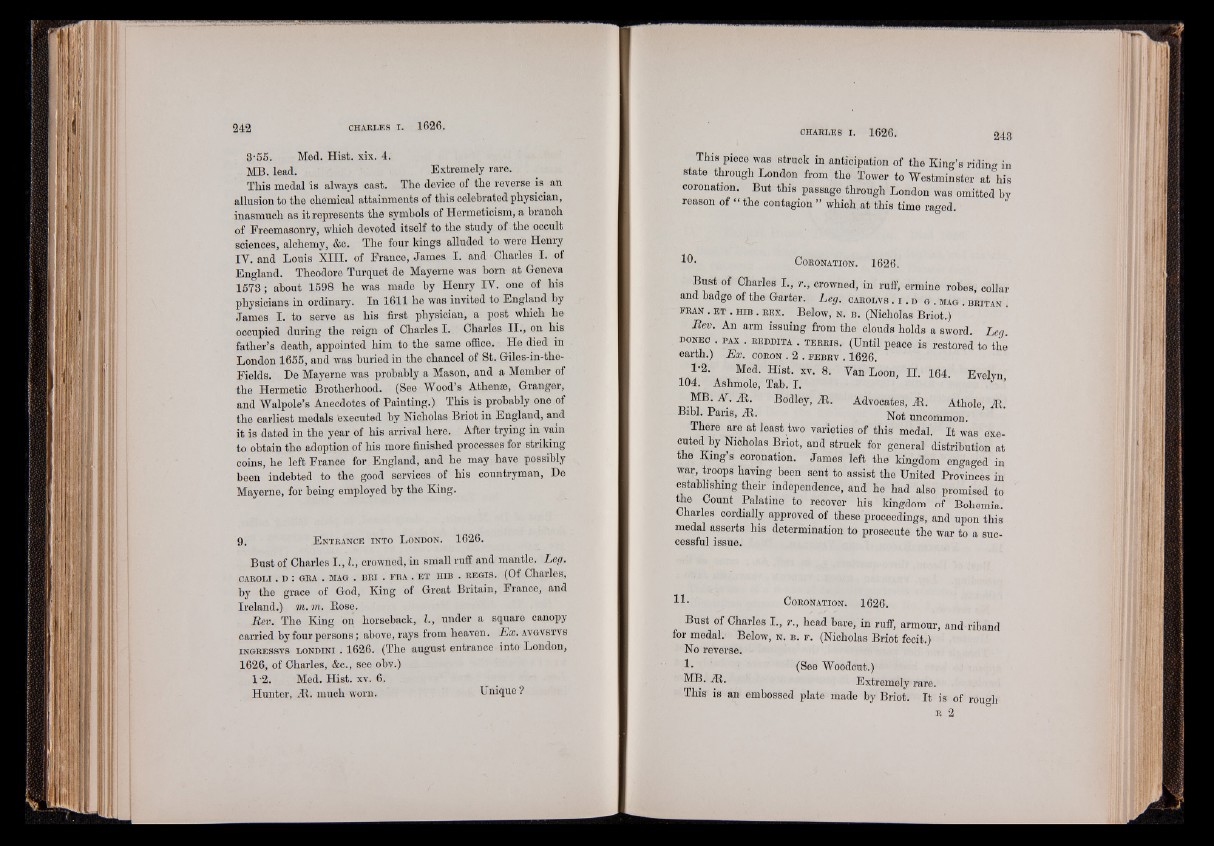
3'55. Med. Hist. xix. 4.
MB. lead. Extremely rare.
This medal is always cast. The device of the reverse is an
allusion to the chemical attainments of this celebrated physician,
inasmuch as it represents the symbols of Hermeticism, a branch
of Freemasonry, which devoted itself to the study of the oocult
sciences, alchemy, &c. The four kings alluded to were Henry
IV. and Louis XIII. of France, James I. and Charles I. of
England. Theodore Turquet de Mayerne was born at Geneva
1573; about 1598 he was made by Henry IV. one of his
physicians in ordinary. In 1611 he was invited to England by
James I. to serve as his first physician, a post which he
occupied during the reign of Charles I. Charles II., on his
father’s death, appointed him to the same office. He died in
London 1655, and was buried in the chancel of St. Giles-in-the-
Fields. De Mayerne was probably a Mason, and a Member of
the Hermetic Brotherhood. (See Wood’s Athens, Granger,
and Walpole’s Anecdotes of Painting.) This is probably one of
the earliest medals executed by Nicholas Briot in England, and
it is dated in the year of his arrival here. After trying in vain
to obtain the adoption of his more finished processes for striking
coins, he left France for England, and he may have possibly
been indebted to the good services of his countryman, De
Mayerne, for being employed by the King.
9. E n t r a n c e i n t o L o n d o n . 1626.
Bust of Charles I., I., crowned, in small ruff and mantle. Leg.
CAROLI . D : GRA . MAG . BRI . FRA . ET HIB . REGIS., (Of Charles,
by the grace of God, King of Great Britain, France, and
Ireland.) m.m. Rose.
Rev. The King on horseback, I , under a square canopy
carried by four persons; above, rays from heaven. Ex. a v g v s t v s
i n g r e s s v s l o n d i n i . 1626. (The august entrance into London,
1626, of Charles, &c., see obv.)
1-2. Med. Hist. xv. 6.
Hunter, At. much worn. Unique ?
This piece was struck in anticipation of the King’s riding in
state through London from the Tower to Westminster at his
coronation. But this passage through London was omitted by
reason of “ the contagion ” which at this time raged.
10. C o r o n a t i o n . 1626.
Bust of Charles I., r., crowned, in ruff, ermine robes, collar
and badge of the Garter. Leg. c a r o l v s . i . d g . m ag . b r i t a n .
f r a n . e t . h i b . r e x . Below, n . b . (Nicholas Briot.)
Rev. An arm issuing from the clouds holds a sword. Leg.
DONEO . PAX . r e d d i t a . t e r r i s . (Until peace is restored to thé
earth.) Ex. c o r o n . 2 . f e b r v . 1626.
1-2. Med. Hist. xv. 8. Van Loon, II. 164. Evelyn
104. Ashmole, Tab. I.
MB. N . At. Bodley, At. Advocates, At. Athole, At.
rri. ^ ar*S’ Not uncommon.
There are at least two varieties of this medal. It was executed
by Nicholas Briot, and struck for general distribution at
the King’s coronation. James left the kingdom engaged in
war, troops having been sent to assist the United Provinces in
establishing their independence, and he had also promised to
the Count Palatine to recover his kingdom of Bohemia.
Charles cordially approved of these proceedings, and upon this
medal asserts his determination to prosecute the war to a successful
issue.
C o r o n a t i o n . 1626.
Bust of Charles I., r., head bare, in ruff, armour, and riband
for medal. Below, n . b . f . (Nicholas Briot fecit.)
No reverse.
1* (See Woodcut.)
MB. At. Extremely rare.
This is an embossed plate made by Briot. It is of rough
r 2